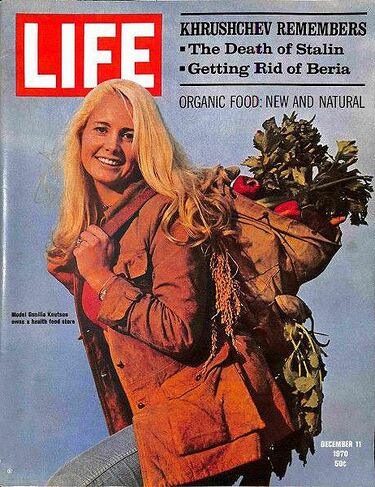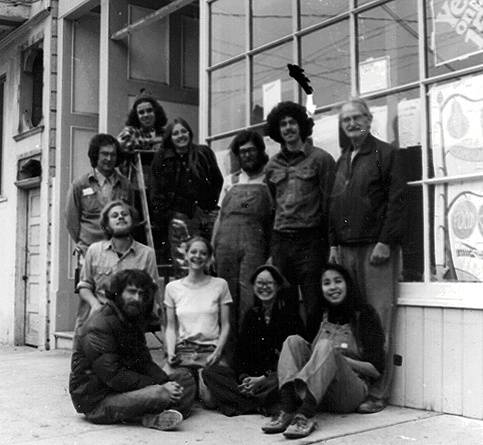Food Conspiracy Roots
I was there . . .
by John Curl, Part Two of an excerpt from a longer essay “Food for People, Not for Profit: The Attack on the Bay Area People’s Food System and the Minneapolis Co-op War: Crisis in the Food Revolution of the 1970s”
- By means of the easy and the simple
- we grasp the laws of the whole world.
- — I Ching
On the cover of Life magazine, December 11, 1970, beneath the headline, ORGANIC FOOD: NEW AND NATURAL, stands a young woman carrying a backpack overflowing with vegetables. Inside is a photo of a group on a porch packing boxes of produce, with the caption, “Saturday morning, leaders of the Food Conspiracy, a local coop in Berkeley, pick up their produce then take it to their areas.” This was one of the earliest recognitions in the national media of the organic and natural food movement, so ubiquitous today. A photo spread, “Staples of a 1970 natural food market,” displays whole grain breads and crocks of nuts, beans, seeds, grains, and dried fruit, curious objects rarely seen in middle America at that time. “New converts to organic food are sprouting up all over: The Move To Eat Natural.” The article explains, “On a mass scale, organic foods and a supermarket economy are incompatible, although a few small chains do stock organic produce. In the main, the demand is met by small country-style stores. Where local stores are nonexistent or inadequate, devotees solve some of their problems . . . by forming co-ops.”(6)
I was a member of the Berkeley Food Conspiracy in 1971-1973. It was a loose, ever-shifting network of autonomous food buying clubs or collectives, mostly organized on a neighborhood basis, among networks of friends, many from communal households, or some common organization. Representatives from the households would gather weekly at their neighborhood center to work out the orders and volunteer for jobs. Our group was called Bay Duck. It was a typical neighborhood food conspiracy. Volunteers kept it together. Jobs rotated. Members got a written list once a week that we used to place orders. Each week, a couple of people would go down to the Oakland wholesale market and other locations early in the morning to buy produce, cheese, grains, beans, eggs, and other dairy products. The group might decide to buy a case of peaches or a sack of pinto beans to divide among members. The jobs rotated, but usually fell on a few dedicated core people, like my friend Leif. He and I and others would rouse ourselves, meet at 4 a.m. and drive in his van down to the produce market. The regulars knew all the good places to go. We brought the haul back to Bay Warehouse Collective, at 5th and Gilman streets, where we both worked, and where conspiracy members divided the loot into boxes and bags with each person’s name on it. Members would come in to pick it up, or in some cases it would be delivered. There was always a basic box of mixed produce that you ordered for a certain price. You never knew what was going to be in it, and in what amounts, for that would depend on what deals the buyers could negotiate. It was a good package, but you had to be prepared to sometimes wind up with things like twenty Jerusalem artichokes or rutabagas. Many of the core members of Bay Duck worked in Bay Warehouse Collective, a group of shops in the warehouse, sharing income and dreams, running the operation by direct democracy and consensus. We pooled all the income of the print, auto and wood shops, and paid workers according to need, which was not a simple thing to do. In the fall of 1973, when Bay Warehouse fell apart, so did Bay Duck.
The larger Berkeley Food Conspiracy officially called itself the Organic Food Association. They explained themselves in the local “underground” newspaper New Morning:
The reasons for starting or joining a Food Conspiracy are everywhere . . . It is getting away from the poisoned food, outrageous prices, and glaring sterility of a Safeway’s or Lucky’s. It is practicing self-reliance, using ‘politics’ as an active verb and forming visions of a rational and loving future. By providing a secure market for organic food, the conspiracy enables small farmers to make it. By encouraging ecological agriculture and by defending it, Food Conspiracy does subvert the institution of monopoly landholding under which California has been ravaged for a hundred years. Food Conspiracy is also work. In order to buy, load, divide vegetables, cheese, milk, chickens, eggs and dry goods, everyone must share the labor. Responsibilities are rotated so that everyone becomes familiar with all the jobs.(7)
These impromptu food co-ops first appeared in San Francisco in the late 1960s, inspired by the free giveaways of scavenged food in parks started in 1966 by the Diggers, a “leaderless” countercultural activist group. The Haight-Ashbury neighborhood was the locus for the first few years. No one person claims credit for originating the San Francisco Food Conspiracy; from all reports it was a true grass roots community formation, springing up from several sources at about the same time. Groups of friends, including communal and cooperative households, began to pool their resources and buy directly from small wholesale distributors and the local farmers’ market, bypassing the corporate supermarket system and bringing home healthier food at the better prices. The countercultural community in Berkeley, home of the Free Speech movement, directly across the bay, quickly became a second hub. The networks interacted closely as the Bay Area Food Conspiracy, and in many ways formed a single community with two centers. The Haight-Ashbury Food Conspiracy, the largest neighborhood group in the Bay Area, began in 1968 and in 1973 reached 150 member houses, involving around 700 people. The Berkeley-Oakland Organic Food Association had some twenty-eight affiliated neighborhood conspiracies in 1972. Many other conspiracies were unaffiliated. The Bay Area Food Conspiracy at its height probably involved around 2,000 people.(8)
The hippies, the counterculture, the Diggers’ giveaways, the food conspiracies, were all made up of volunteers giving freely of their time, all based on mutual aid for survival outside the system. At their core was the idea of creating a nonviolent revolution by living it, changing the world by seizing power over our lives, as we interfaced with everyday activities. The countercultural revolutionaries wanted healthier food and began to focus on direct action to change the food chain. By circumventing the corporate food distribution channels, and opening paths for new and better foods, members saw themselves as participating in a radical nonviolent social transformation.
Most of the people involved in the Food Conspiracy were under thirty years old. Money was scarce in the counterculture community, and many had more time than cash. Decisions were made by consensus, often by whoever showed up at a meeting. Some political groups also operated food conspiracies. The early conspiracies distributed foods that were not generally available in supermarkets and were often the first place that many people encountered bulk, natural and whole grain foods.
The food conspiracies were owned by no one, in part because there was nothing to own. There was no property outside of the products, and those were entirely distributed each week, so there was no stock. The conspiracy was not a business, so it had no monetary value of its own. The conspiracies were nonprofit, informal, below the social radar of business licenses and taxes. Their flexible, ever-changing, minimal structures reflected their countercultural origins. They were by their very nature egalitarian, making decisions by direct democracy. Leadership was determined by whoever was willing to put in the work, and by force of personality. Jobs rotated, with few or no fixed positions. Most of the planning, division and distribution took place in somebody’s home, porch, or garage.
For some, the conspiracy was primarily a way to get inexpensive foods that were not usually available in supermarkets and were exorbitantly expensive when you could find them. These included a wide variety of vegetables, cheeses, tofu and other soy foods, and organic pesticide-free foods. For many, the conspiracy was also about having some control over where the food came from, how it was grown, transported and processed. For many others it was part of a larger movement to transform society.
The counterculture was at its roots a movement of social transformation, with much of its power stemming from the concept that if each of us lives the Revolution, it will result in vast social changes: the personal is political. But others saw that any serious attempt to fulfill a social mission had to extend beyond the counterculture enclaves whose population was predominantly young, college-educated, and white. The early movement reached its natural limits and stalled there.
Many in the food conspiracy wanted to reach beyond those limits. Issues involving the politics of food were constantly hitting the mainstream news, such as farmworker strikes and boycotts, and many food conspiracies became deeply involved in their support. Various political activist groups became involved in different neighborhood conspiracies. The government was using what was called “the food weapon” in foreign policy, and that became a hot issue.(9) Some food conspiracies published newsletters which commonly included anti-war demonstration alerts, rent control activism, guidelines for boycotting grapes, lettuce, and wines, and updates on United Farmworkers Union activities. John Carter, editor of Communications, newsletter of the Haight-Ashbury Food Conspiracy, looked back decades later and commented, “It was at least as much about building a new society as it was about getting ourselves fed. We were changing the world in every aspect of our lives. Our food conspiracy newsletter became a housing resource, a study guide, a tool for organizing our anti-war protests. We’d use it to coordinate who was bringing the cloths soaked in vinegar to use when we got tear gassed.”(10)
Food Conspirators like these got together to start storefronts around San Francisco, organized under the People's Food System. Photo: Teitelbaum
But the Food Conspiracy “had grown so large that it became very difficult to manage,” as Carter put it.(11) The structure was based on small, dedicated core groups putting in long hours of work for no pay to keep things organized. This resulted in a dynamic movement, but an unstable one. Each local conspiracy was like a start-up business, sustained by what is usually considered sweat equity if the business becomes successful. But there was no payback anywhere in sight. Key people would burn out and be suddenly gone. Many of the core people lived marginally on very little money and were having their survival needs met through methods such as savings, loans, a part time job, help from family, food stamps, unemployment insurance, or other public assistance. Though still young, the counterculture generation was quickly getting to the age where they were starting families and careers, and most didn’t want to continue on the economic margins. Many stopped living communally. Certain jobs in each local food conspiracy clearly required more work and responsibility than anybody could volunteer to do permanently. If the Food Conspiracy was going to be sustainable, key workers had to be paid. Patty Siegel, who hosted the Inner Sunset Food Conspiracy for several years in her house, explained that they “realized that the Food Conspiracy just got too big to happen out of our house. Eventually, ours transformed into a little store, the Inner Sunset Food Co-op.”(12) The “new wave” food co-op movement was the Food Conspiracy’s—and the counterculture generation’s—entry into mainstream economics.


